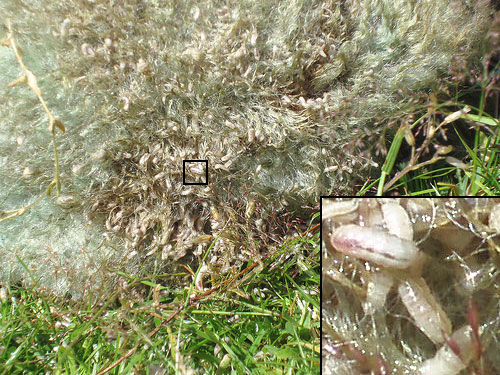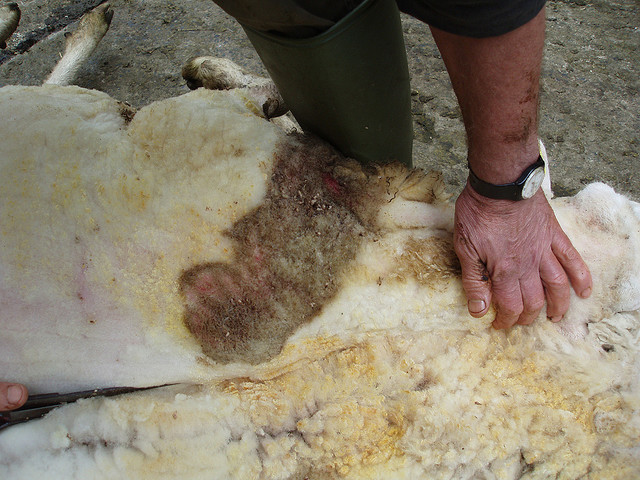 Mulesing is the surgical removal of wool-covered skin in the breech area (buttocks) of the sheep and is currently the only method that gives the sheep a lifelong protection against breech flystrike.5 It is recommended only for sheep that will be raised to adulthood and also raised in an environment with high rates of flystrike.5 By removing the wool-covered skin, the skin that replaces it once healed is smooth and bare. The Merino and Merino-crosses are have a high amount of skin folds, making it easy for urine and fecal matter to collect in the wool.3
Mulesing is the surgical removal of wool-covered skin in the breech area (buttocks) of the sheep and is currently the only method that gives the sheep a lifelong protection against breech flystrike.5 It is recommended only for sheep that will be raised to adulthood and also raised in an environment with high rates of flystrike.5 By removing the wool-covered skin, the skin that replaces it once healed is smooth and bare. The Merino and Merino-crosses are have a high amount of skin folds, making it easy for urine and fecal matter to collect in the wool.3
The Code of Practice recommends that mulesing occurs between 2-12 weeks of age and can be done without anaesthesia.5 Any sheep that is mulesed after 6 months of age must be provided with anaesthetics.5 A cradle is recommended to hold the lamb in place during the mulesing procedure to prevent injury to both animal and handler.5 Lambs must be allowed to go back to their ewes as soon as possible and monitored every 3 days for a minimum of 4 weeks to check for infection.5 The mulesing procedure is legal and recommended by the Department of Agriculture, Fisheries and Forestry as well as the RSPCA.2
Mulesing is done to prevent cutaneous myiasis, which is known as blowfly strike, flystrike and breech strike.1 Flystrike is a serious disease where blowflies are attracted to the area because of the smell of urine and fecal matter and they lay their eggs in the wool.1 When the larvae hatch, they will feed on the living flesh of the sheep and this can cause severe infections and death.7 The mulesing procedure has been found to cause a stress response in the animals for 24-48 hours post-mulesing.4 The lambs return to their normal activity levels after 48 hours.4
Due to the negative media attention from PETA’s Save the Sheep campaign, wool producers have been putting money towards finding an alternative to surgical mulesing. Wool producers only find the mulesing procedure acceptable because it does prevent a life-threatening disease in the their animals.7 Surgical mulesing can decrease incidences of flystrike in areas with high rates of flystrike by up to 90%.4 Flystrike costs the Australian wool industry $160 million AUD annually.1
Alternatives to mulesing are:
- selective and cross-breeding
- chemical mulesing
- mulesing clips
Selective and Cross-Breeding
The research into selective and cross-breeding has been slow, as development of new kind of Merino takes time. They have crossed Merinos with other breeds that have naturally less wrinkly breech areas or with naturally occurring bare skin.3 The primary concern with cross-breeding is that it changes the quality of wool that is produced by the sheep.3
Chemical Mulesing
Chemical mulesing is a non-permanent procedure that is more expensive than traditional surgical mulesing. Surgical mulesing costs $0.70AUD per animal and that is a permanent mulesing method.4 Cost of chemical mulesing is $0.30-0.46 AUD per animal, but it lasts for 10-24 weeks, depending on the chemical used.4 Also, wool that is grown during the periods that the chemicals are used cannot be sold.4 One chemical mulesing method that was permanent (produces a chemical burn to the skin when applied to the animal) was found to be too toxic and too easy to cause accidental death to the animal from the chemicals.6
Mulesing Clips
Mulesing clips are a reusable method of mulesing the animals. They pinch the skin until the skin dies and falls off, much like the practice of banding with tail-docking.8 The problem that has been found with mulesing clips is that the clips fall off before the process of mulesing is complete.8
Photos from Flickr user northdevonfarmer and TheLand.
1 Colditz, I.G., Walkden-Brown, S.W., Daly, B.L. and Crook, B.J. 2005 Some psychological responses associated with reduced wool growth during blowfly strike in Merino sheep. Australian Veterinary Journal 83 (11): 695-699.
2 Department of Agriculture, Fisheries and Forestry. Feb 16 2011. Mulesing in Australia Available at: http://www.daff.gov.au/animal-plant-health/welfare/animal_welfare_issues/mulesing_in_australia Accessed March 2 2012
3 James, P.J. 2006. Genetic alternatives to mulesing and tail docking in sheep: a review. Australia Journal of Experimental Agriculture 46: 1-18
4 Lee, C. and Fisher, A.D. 2007. Welfare consequences of mulesing sheep. Australian Veterinary Journal 85 (3): 89-93.
5 Primary Industries Ministerial Council 2006 Model Code of Practice for the Welfare of Animals – The Sheep, 2nd Edition. CSIRO Publishing, Collingwood.
6 Rothwell, J., Hynd, P., Brownlee, A., Dolling, M. and Williams, S. 2007 Research into alternatives to mulesing. Australian Veterinary Journal 85 (3): 94-97.
7 Sneddon, J. and Rollin, B. 2010. Mulesing and Animal Ethics. J. Argric Environ Ethics 23: 371-386
8 Wells, A.E.D., Sneddon, J., Lee, J.A. and Blache, D. 2011. Farmer’s Response to Societal Concerns About Farm Animal Welfare: The Case of Mulesing. J. Agric Environ Ethics 24: 645-658.


